On Monday 1st May 2023 ultrarunning adventurer Nikki Love embarked on an epic 4000km run across Australia, realising a long-held dream. When she set off from Cottesloe Beach in Perth, Nikki could not know that she could make it to the finish at Bondi Beach in Sydney. Her preparation in the three months before had not gone well. In the first part of this interview, we talk about the build-up to Nikki’s run across Australia, the start of the run, the practicalities of making it work and the challenges involved. Nikki talks about her ability to draw on her life experience and running experience, to learn from failure and to adapt.
Dreaming big
I first met and interviewed Nikki Love in 2017 when she was about to embark on her 63 marathons in 63 days challenge. Nikki talked about how each of her challenges served as learning for the next challenge and the importance of “dreaming big”. After completing the 63 marathons, there were more adventures. In 2018 Nikki ran around Ireland, in 2019 she ran the length of Wales and then ran across the Netherlands (video interview here). In 2020, during Covid, she undertook a treadmill challenge at home, running 1000 miles. This was 40% of the distance she would need to run to cross Australia.
All of this time Nikki’s goal of running across Australia was part of the big picture of her life. She talked about it happening, even when she knew it was a long way off. There have been many stages along Nikki’s journey to that big goal and several setbacks. She has had to adapt her plans several times, but has always held onto her vision. This year she made it a reality.
The run across Australia and the record
Nikki’s run across Australia started on Monday 1st May 2023 at Cottesloe Beach in Perth. It finished at Bondi Beach in Sydney on Sunday 16th July. Nikki’s time was 76 days 3 hours and 43 minutes.
She is the first woman to attempt to set a Guinness World Record on this route. She has submitted a claim to Guinness World Records for the fastest journey on foot across Australia (Perth to Sydney) by a woman.
The current men’s record is held by Donnie Maclurcan who ran from Perth to Sydney in 67 days, 2 hours and 57 mins from 5 January to 13 March 2002.
Nikki has submitted her data to the Fastest Known Time website and they’ve accepted it as the Perth to Sydney FKT (see here).
A long journey to the start
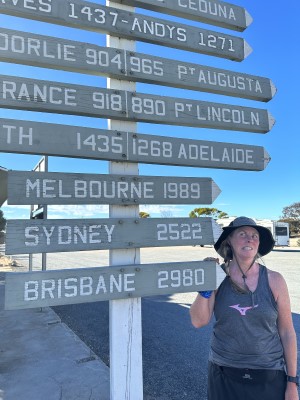
Nikki reflected on how long it had taken to get to do the run.
“It’s really nice to think that you’ve been along for the entire process because it’s taken such a long time. It’s hard to get that across. This wasn’t just, ‘I fancy running across Australia, I’ll go and do it now.’ It’s taken such a long time to get to that point. And there were so many times when I could have stopped and given up because that would have been an easier option. Because the alternative was doing the hard work and having knockbacks and setbacks.
There was a lot of tears in the process of building up to it. At some point you could say, ‘This is just too much. Stop.’ But thankfully I don’t have that kind of mindset. I’m so grateful that I haven’t. I wouldn’t do these things if I had a normal thinking pattern.”
The three months before the start – a setback
“The last three months didn’t go very well. In January I had a fall on black ice and hurt something around my pelvic area. There was a serious pain. I did try to run the next day. I ran for 30km and had to phone Sharif and ask him to come and pick me up because I was in so much pain.”
Nikki went to see her osteopath who recommended getting a private MRI scan. She was saving for Australia and decided not to get the scan. Having had a pelvic stress fracture in 2021, she knew that the advice would be to rest and keep off her feet. So that’s what she did.
“By the end of February I still wasn’t running. I’d got my ticket and had my start date of May 1st. We had everything planned. I spent most nights thinking, ‘Should I go?'”
Following the plan
“We decided to follow the plan and see what happened. So, I got on the flight at the end of February and went to Australia. The day after arriving, I went for a run to test it. It was still painful and I couldn’t run. Sharif was still in the UK. He suggested that I find somebody to see. I was staying with my parents in Geelong and I went to see a physio there. He examined me and said he could treat me. We started rehab in March and within a week I was back running again. I rehabbed and went to see him every two weeks and did the training to get myself on the start line on 1st May.
“I had to think that I could do the run, I had to train so that I could do the run. I was trying to raise crowdfunding up to the start date. I was thinking, ‘What do I say to people? Do I say That I’m injured?’ I had to go with my gut. I trusted that I’d done a lot of training prior to the injury. I was starting to feel better with the treatment, and I was just going to give it my best shot.
“The furthest run I did was 30k and I did that without pain. I was comfortable with that. And over the week I managed to clock up 110km.”
Drawing on experience
We talked about how Nikki was able to draw on her lifetime of experience to know that she was going to be OK to start. She knew she was going to have pain from trying to run a long distance every day. But she knew she could manage that because she had experience of going through an adaptation phase where everything hurts.
“That adaptation phase has been my experience right throughout my running. It started even from running my very first marathon. Anybody who’s run a half marathon knows that it hurts at the end, and it takes a few days to recover. Then you go up to full marathon and you have that same experience. It has been an incremental build up of distance and doing more days. I can even go back to the very first long distance run I did at high school, cross country, it was 3 kilometres. I remember the excitement of doing that but the next day I was a bit stiff and sore because I’d done something I’d never done before. Each increment has had its adaptation phase.”
Getting to the start of the run across Australia
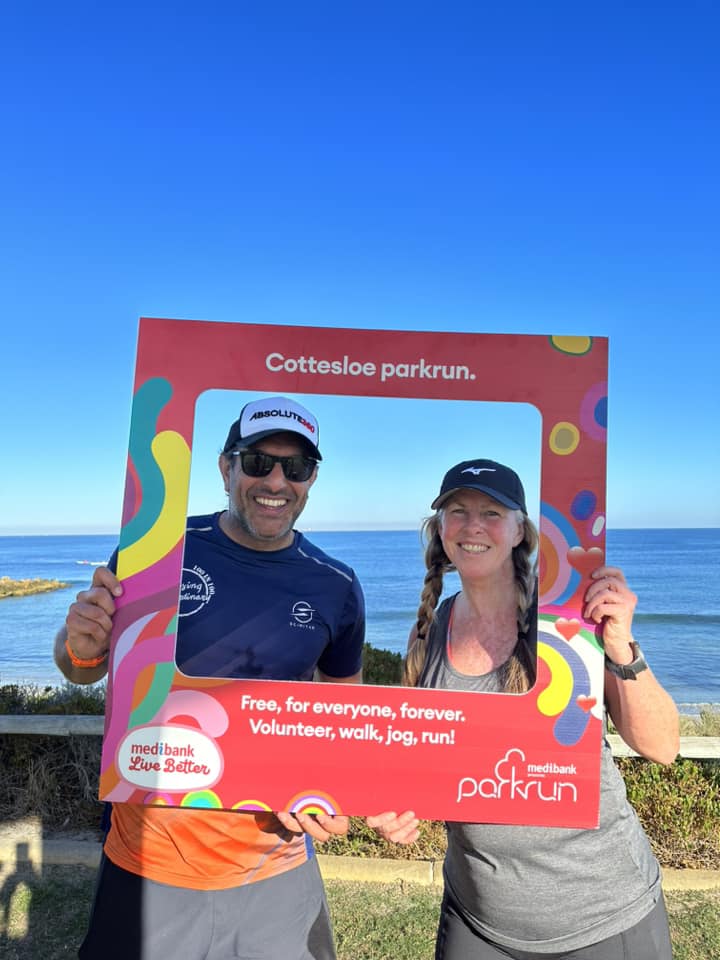
“Sharif came out to Australia in the middle of April, ten days before the start. We’d booked the van, but we weren’t able to pick it up until four days before we left.
“It took five days to drive to Perth. It was just short of 4000km from my Mum and Dads’ house to the start line. We got there two days early, arriving on the Friday night. I’ve got a cousin there, so we stayed at her house. We did parkrun on Saturday at Cottesloe Beach. On the Sunday we did the final shop and set off on Monday.
“There was a lot of planning and a lot of planning on the hoof. We realised that it doesn’t matter how much planning goes into it, the reality is always going to be different. Unless you’ve done exactly the same thing before, you’re not going to know everything. We had to adapt as we went along. It wasn’t just the physical side for me, it was also adapting to living in the van.”
Equipment
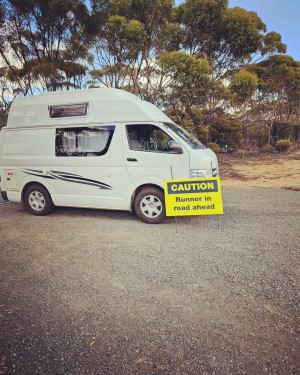
“We realised we needed more equipment to survive the long stretch of the Eyre Highway, which is 1650km across the empty part of Australia, the desert area. It’s 200 to 250km between roadhouses and there’s nothing else in between those roadhouses. There is nowhere to buy equipment.
“We needed charging equipment, an extra leisure battery. We had a solar panel and a leisure battery in the van, but it wasn’t enough to charge everything and keep the fridge freezer going, which had all the food in it. The last place to get equipment was 60km off my route in a place called Kalgoorlie. That was at the end of the second week. We weren’t going to be at another place where you could buy technical equipment until week eight. It was two weeks into the run, and I was in a lot of pain, struggling. I didn’t want to be left alone for the day. So, I took day 13 off running. We drove to Kalgoorlie, picked up all the stuff we needed and came back to the same place.”
Challenges – the roads
Most people doing multi-day challenges have two vehicles and several people in the support crew. I was interested to understand how Nikki and Sharif managed with one vehicle. How did they handle the challenge and risks of it just being the two of them?
“It was harder than we’d expected. We had practised. We’d tested the format on the run round Ireland in 2018: one car with Sharif always being 10km ahead of me. It worked. The weather was different, the ability to buy things was different. Whilst we knew that Australia would be different, it was still way harder because of the roads. You’d think in the middle of nowhere it would be easy for Sharif to pull over, but it wasn’t. A lot of the roadsides were banked at 30 degrees. There sometimes wasn’t even a hard shoulder. Being able to get the van off the road and get back onto the road was a big safety issue for Sharif. The trucks were zooming past. My safety issue was either running on the hard shoulder on a camber or on the road.”
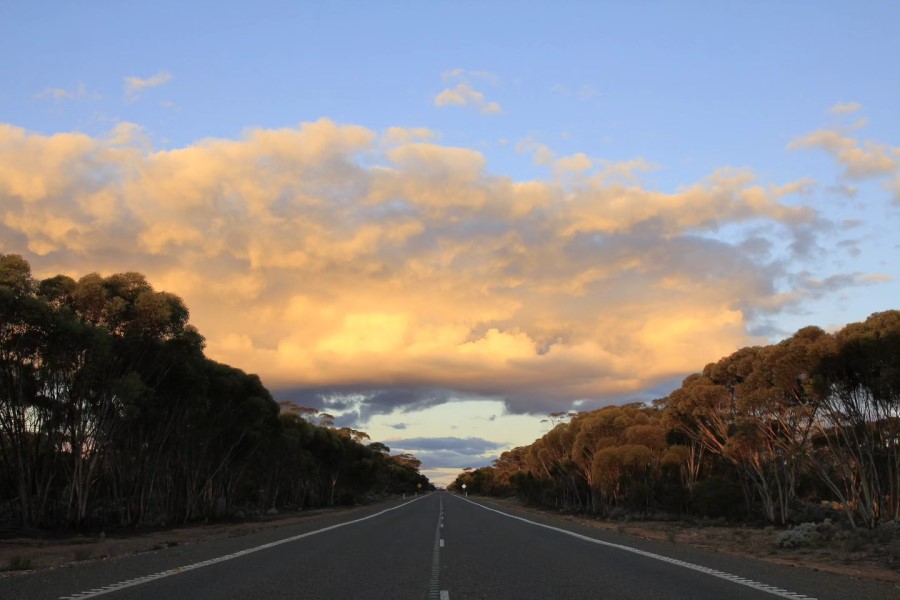
Making it work
What contributed to Nikki and Sharif making it work?
“When we were planning, we had this big picture of what this journey looked like. Sharif wanted a motorhome and that was his absolute minimum. Can we have a team? Can we have another support car? Can we have someone filming it? As it got closer, it cost so much money, the criteria kept dropping and dropping until we had a minimal viable option. Thankfully we get along, Because in a tiny van, tempers fray. We were both tired. We were in the middle of nowhere trying to do our best.”
Nikki and Sharif were pushing themselves well outside their comfort zones.
“Our plan, based on previous experience, was that Sharif would leave me for 10km. We changed this so that he was stopping every 3 to 5 kilometres ahead of me. If I got grumpy or he was grumpy, if he was annoyed at me, he would string that out and drive an extra kilometre ahead. That was his little protest. He told me afterwards. I didn’t notice it at the time.”
Was part of the success down to you both being quite adaptable? You’d had to scale back on your plans.
“We have trust and belief in each other. When I’m struggling he will help me and when he’s struggling I’ll help him. We’d discussed this adventure for such a long time. That meant we were both committed to doing what was going to get us there.”
Adaptability and confronting fears
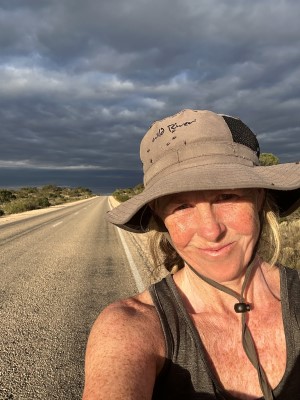
“In my kids book I have superpowers. One of them is adaptability. To be able to do these challenges, you must have an end goal, but you must be able to adapt. I’ve got better at saying, ‘I really want to be able to achieve this but if I don’t my world is not going to collapse.’
It’s about learning through the things that don’t go right. It’s OK to try something that’s going to test you and might not happen but you’re going to do your best to try and get there.
It’s taken a long time for that to come. ‘Feel the fear and do it anyway’. I did that every single day. I truly believe that it’s a process. You’ve travelled alongside the fear. The fear’s been with you the whole time and you survived it.”
In the next part of the interview, we discuss Nikki’s distance goals for the run across Australia, the dangers she encountered on the road and the final day in Sydney.
Links
2017 interview with Nikki before her 63 marathons in 63 days challenge.
2020 video interview with Nikki – Ultrarunning and the Menopause.
Female ultrarunners over 50 – my look at participation in UK races by women over 50.
Check out my recommended blogs list which features several ultrarunners over 50 from the UK and USA.
Notes
All pictures by Sharif Owadally unless stated otherwise.
English long-distance walker Ffyona Campbell walked from Perth to Sydney in 1988, reportedly taking 95 days. She published a book in 1992, “Feet of Clay: Her Epic Walk Across Australia”. She didn’t claim the Guinness World Record.
In 2022, Frenchwoman Marie Leautey crossed Australia during her round the world run. Starting in Perth, she travelled to Adelaide and Melbourne before going to Sydney. Leautey was running a marathon a day and taking a day off a week
Nikki’s children’s book is called “The Girl That Loves to Run” and it’s available from her website.
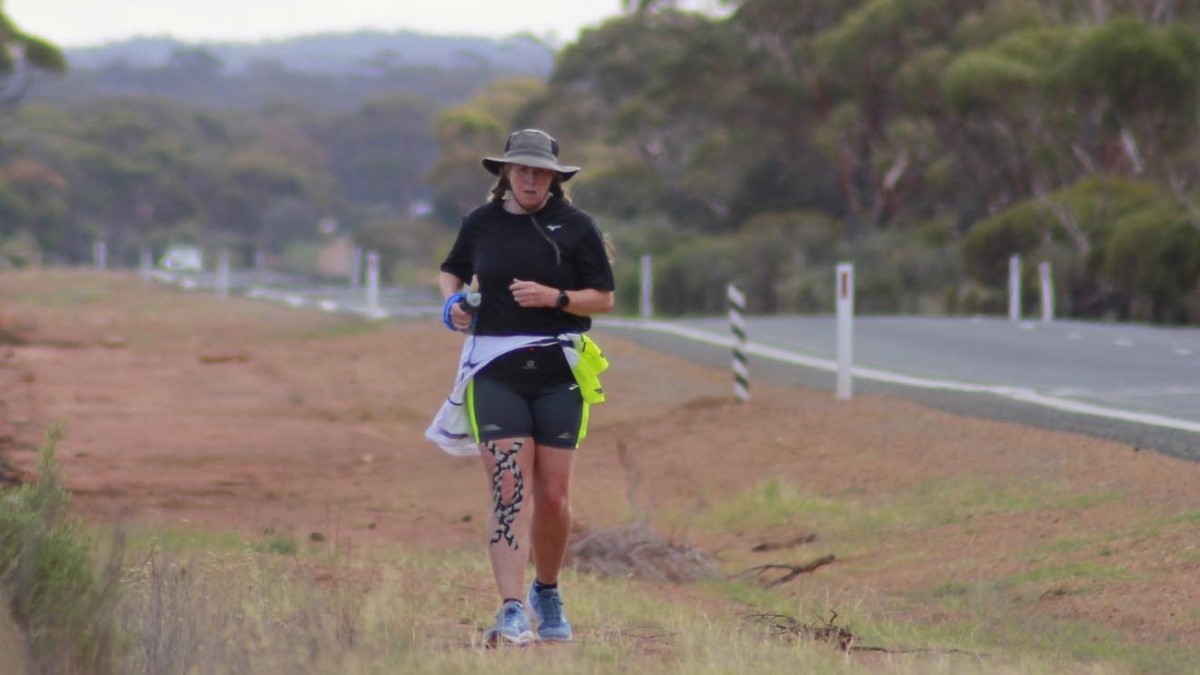
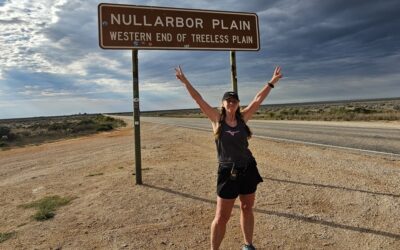

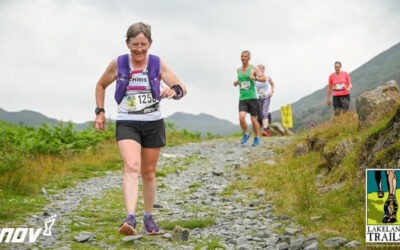
0 Comments